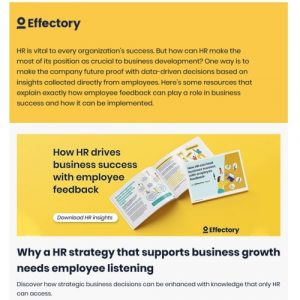A third of employees feel that they were not able to perform to their full potential in the period between the end of March and the beginning of May, an Effectory survey of 85,000 employees has revealed.
Three management lessons learned from the first wave of the COVID-19 pandemic

Since March 12, the working environment of many employees has changed dramatically. This has had a huge impact on their working experience. Many employees have also noticed their performance suffering.
85,000 employees responded to Effectory’s COVID-19 Workforce Pulse check and we would like to share those responses with you. These responses shed more light on the specific factors that lie behind these productivity problems. The survey was carried out from week 14 to week 19 and encompassed 230 organizations.
What lessons can we learn from employee experiences during the first wave of coronavirus cases? How can organizations use this information to make better decisions in the coming weeks and months?
Whitepaper: Hybrid working is the new normal
How are you preparing your company for the changes ahead? Tuning into the needs of your workforce will be vital to compete effectively in the post-COVID world.
DownloadLesson 1: Reduced contact has led to less effective collaboration
“A significant number of employees have clearly struggled with the changes to their working environment,” says Effectory’s Baran Metin, Organizational Psychologist and People Analytics Researcher. “Having to work from home has led to a decrease in performance for a really significant number of employees.”
17% of employees reported that their work was made more difficult because it was harder to contact their colleagues. Of these employees, 38% also reported a reduced ability to carry out their work effectively. Metin says “It is not realistic to expect every employee to be able to provide the same level of commitment as before. This means that team members are having to wait longer for each other’s input.”
Lesson 2: Hardware and software issues reducing efficiency
21% of employees also reported that not being at a proper workstation has impacted their performance. 8% said that they have had difficulties accessing the company network or to production software. Metin says “The quality of technological resources available to employees has a direct influence on performance. Employees whose performance has been affected by hardware and software problems said that their ability to carry out their tasks effectively is down by 17%.”
“For example, for the first two weeks of lockdown, I was working on a laptop. Now I have separate mouse and keyboard as well as two large screens. Since then, I have noticed that I have been so much more productive.”
Lesson 3: Distractions at home can lead to problems concentrating
We heard that 15% of all employees have experienced problems concentrating. 27% of these said this was at least partially due to their children being at home with them while schools and childcare facilities were closed.
25% indicated that they found it hard to concentrate in their work environment because of other people in the house or an otherwise noisy environment.
Metin says “External factors have an extremely significant effect on productivity. This analysis shows that distractions caused by children or other people in the household can reduce employee productivity by as much as half.”
Three factors that impact motivation
According to Metin, the obstacles that reduce employees’ ability to perform at their best also negatively influence their “autonomous” motivation. This refers to the type of motivation derived from the work itself.
Metin says “Deci and Ryan’s self-determination theory outlines the three factors that are important here: A sense of control over your environment, a sense of connection with this environment and the feeling that you are able to make a meaningful contribution. However, employees are often missing these factors now that they have to work remotely due to lockdown.”
Receive the best HR articles in your mailbox
Subscribe to our newsletter and you will receive the best HR articles on a quarterly basis.
Sign upRemedy 1: Increase autonomy by providing the right technological resources
What can organizations learn from this information? How can we increase employee performance while still working remotely?
“This can be achieved by doing as much as possible to remove any obstacles, thereby creating the conditions that will enable your employees to work from home successfully,” says Guido Heezen, Founder of Effectory. “First and foremost, this means providing your employees with the right technological resources.”
Remedy 2: Explain to employees how they can make a meaningful contribution
Organizations can also help their employees to improve their autonomous motivation by providing clear direction. Heezen says “Your task now is not only to make sure that your employees can work to the best of their ability—as far as their home situation permits—but also to ensure that they actually want to work to the best of their ability. The most powerful way to do this is to involve them and to think together about how you can keep embracing your mission during and after the coronavirus pandemic.”
Remedy 3: Encourage a sense of togetherness
We have also seen that it is often necessary to help teams to establish a new sense of stability while working from home. Heezen says “This can be achieved by encouraging team members to be honest about what they can realistically achieve, based on their working environment and the hours when they are most easy to contact. Once expectations are clear, you can reach new agreements about how you will work with each other and determine whether or not those agreements actually work in practice.”
Organizations can also encourage their employees to strengthen their sense of togetherness. Heezen says “For example, Effectory has begun holding virtual work drinks every Friday, a virtual lunch every day and has also set up virtual tea and coffee breaks that employees can attend at set times for informal meetings with their colleagues.
Remedy 4: Good crisis communication
In recent weeks, a focus for organizations has been demonstrating not only good crisis management, but also good crisis communication. Metin says “Communicating regularly with employees and addressing their concerns can help to make the situation easier. This will increase trust in the organization in the future, in turn motivating employees to commit to performing to their full potential.”
Heezen says “The trick is to keep your organization as energized as possible, even during these difficult times. This could make the difference between ultimately going under, and getting a head start when we get back off the ground.”
Custom scans for essential workers
In addition to the Effectory COVID-19 Workforce Pulse surveys, Effectory has also developed a special set of questions for key workers in essential sectors such as healthcare. This is also a Pulse survey — a very short survey that employees can easily fill in on their smartphone.
Book a free demo. See our solutions in action.
Effectory is Europe’s Leading provider of Employee Listening Solutions. Schedule a product demo and discover how to enhance your employees’ engagement.
Demo request

